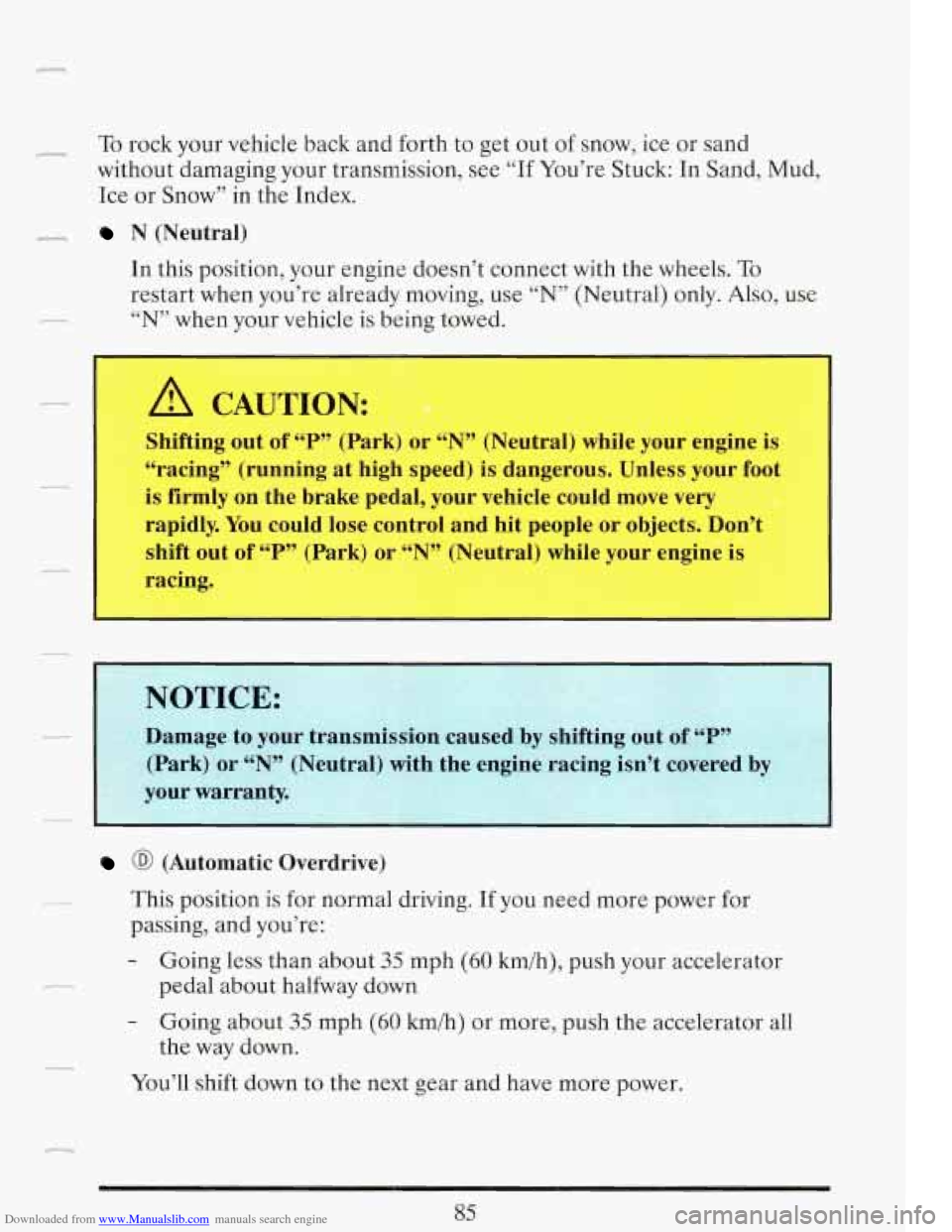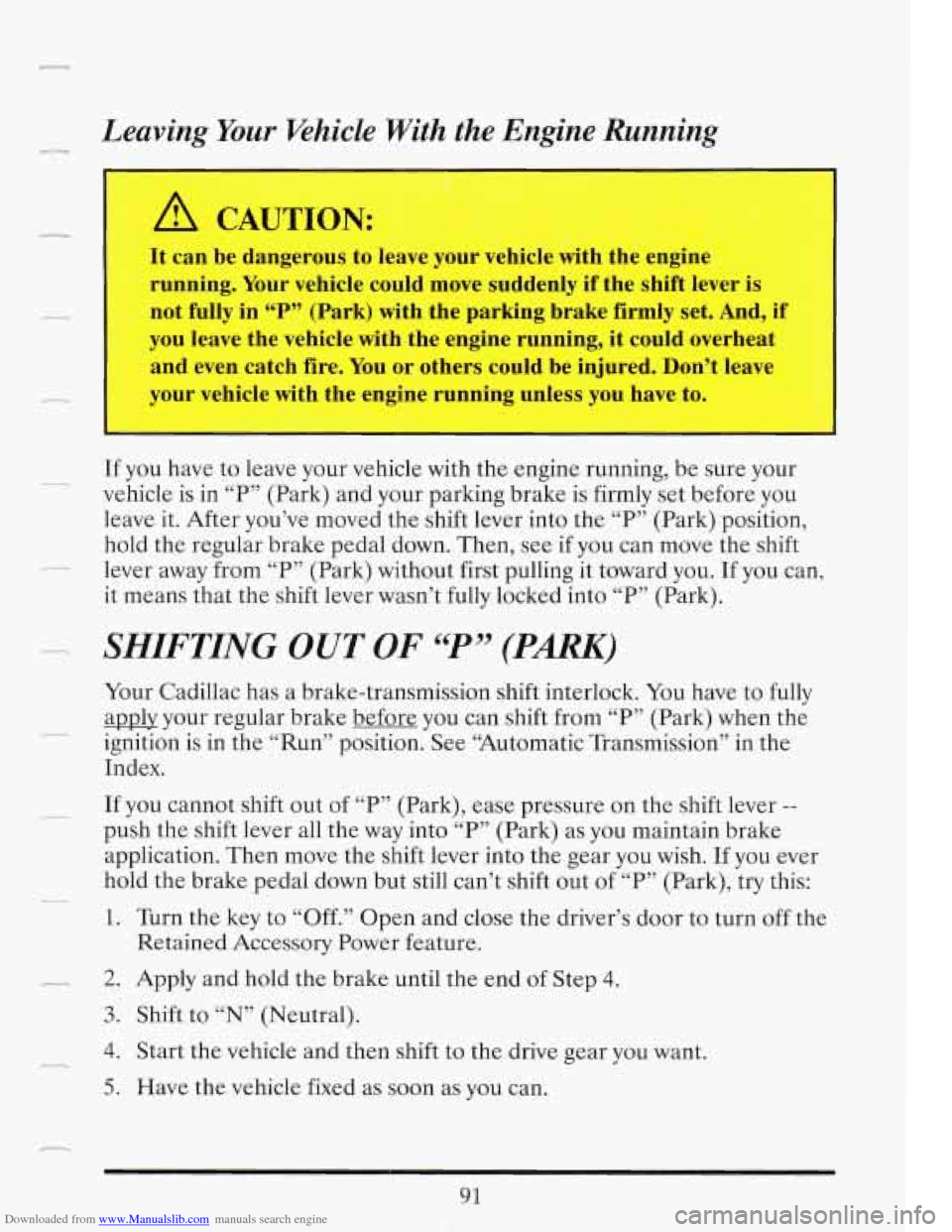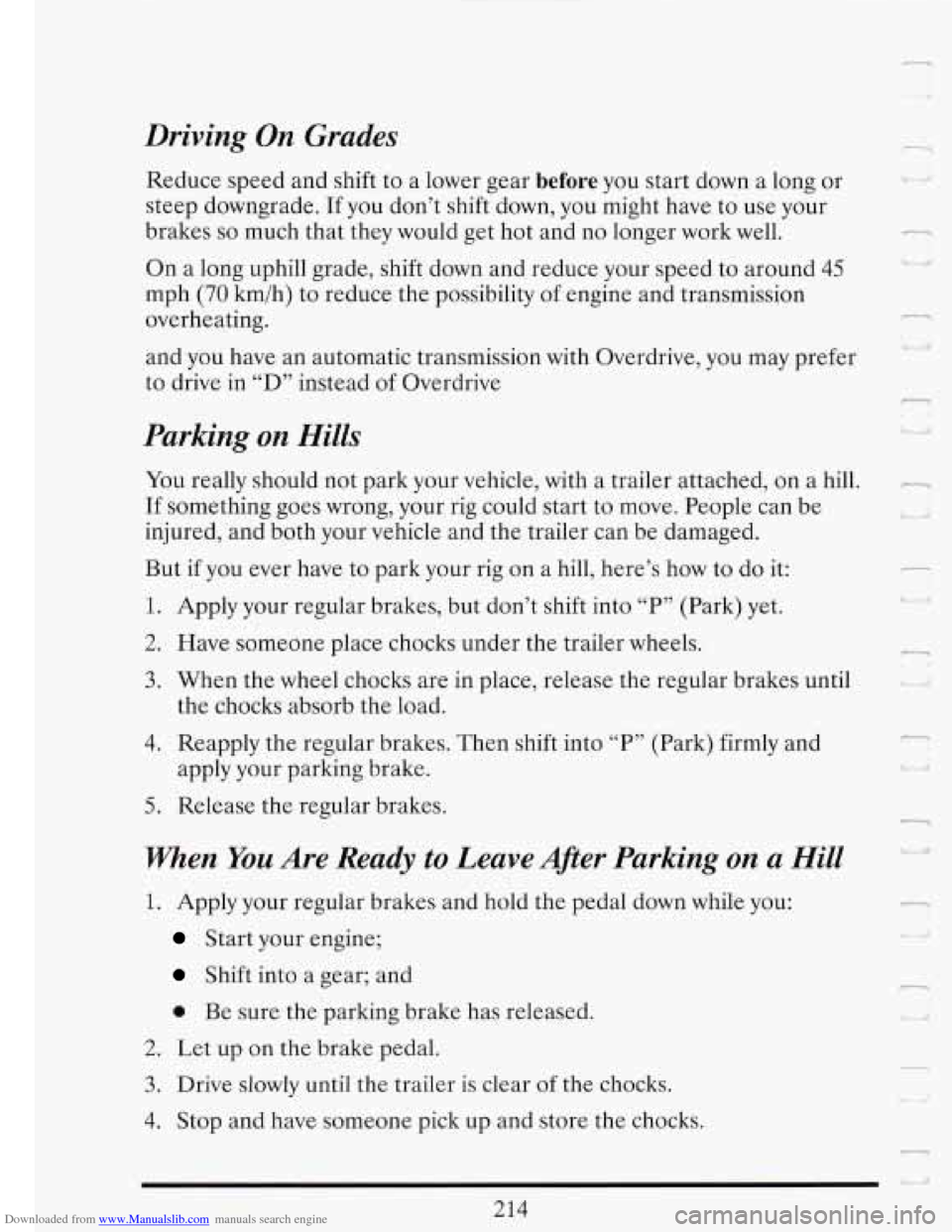Page 99 of 386

Downloaded from www.Manualslib.com manuals search engine r To rock your vehicle back and forth to get out of snow, ice or sand
without damaging your transmission, see
“If You’re Stuck: In Sand, Mud,
Ice
or Snow” in the Index.
N (Neutral)
In this position, your engine doesn’t connect with the wheels.
To
restart when you’re already moving, use “N” (Neutral) only. Also, use
“N” when your vehicle is being towed.
A CAUTION:
Shifting out of “P” (Park) or “N” (Neutral) while your engine is
“racing” (running at high speed) is dangerous. Unless your foot
is firmly on the brake pedal, your vehicle could move very
rapidly. You could lose control and hit people or objects. Don’t
shift out of
“P” (Park) or “N” (Neutral) while your engine is
racing.
c
c-
r
@ (Automatic Overdrive)
This position is for normal driving.
If you need more power for
passing, and you’re:
- Going less than about 35 mph (60 kmih), push your accelerator
- Going about 35 mph (60 km/h) or more, push the accelerator all
You’ll shift down to the next gear and have more power.
pedal about
halfway down
the way down.
85
Page 105 of 386

Downloaded from www.Manualslib.com manuals search engine Leaving Your Pkhicle With the Engine Running
----
A CAUTION:
It can be dangerous to leave your vehicle with the engine
running. Your vehicle could move suddenly if the shift lever is
not fully in “P” (Park) with the parking brake firmly set. And, if
you leave the vehicle with the engine running, it could overheat
and even catch fire. You or others could be injured. Don’t leave
your vehicle with the engine running unless you have to.
If you have to leave your vehicle with the engine running, be sure your
vehicle is in “P” (Park) and your parking brake is firmly set before you
leave it. After you’ve moved the shift lever into the “P” (Park) position,
hold the regular brake pedal down. Then, see if you can move the shift
lever away from “P” (Park) without first pulling it toward you. If you can,
it means that the shift lever wasn’t fully locked into “P” (Park).
SHIFTING OUT OF “P” (PARK)
Your Cadillac has a brake-transmission shift interlock. You have to fully
apply your regular brake before you can shift from “P” (Park) when the
ignition is in the “Run” position. See “Automatic Transmission” in the
Index.
If you cannot shift out of “P” (Park), ease pressure on the shift lever --
push the shift lever all the way into “P” (Park) as you maintain brake
application. Then move the shift lever into the gear you wish.
If you ever
hold the brake pedal down but still can’t shift out
of “P” (Park), try this:
1.
2.
3.
4.
5.
Turn the key to “Off.” Open and close the driver’s door to turn off the
Retained Accessory Power feature.
Apply and hold the brake until the end of Step
4.
Shift to “N” (Neutral).
Start the vehicle and then shift to the drive gear you want.
Have the vehicle fixed as
soon as you can.
91
Page 126 of 386
Downloaded from www.Manualslib.com manuals search engine The high beam headlights will come on at reduced brightness in daylight
when:
The ignition is on
The headlight switch is off, and
The transmission is not in “P” (Park).
At dusk, the DRL will switch off and the exterior lights
will come on
automatically. At dawn, the exterior lights will go out and the high beams
will change to the reduced brightness
of DRL (if the headlight switch is -
off).
Of course, you may still turn on the headlights any time you need to. W
To idle your vehicle with the DRL off, shift the transmission into “P”
(Park), turn the ignition
OFF, and then restart your engine. The DRL will -.
stay off until you shift out of “P” (Park). cd. 1
Reading Lights
Here’s where you turn them on:
n
c1 ’!
112
Page 142 of 386
Downloaded from www.Manualslib.com manuals search engine A CAUTION:
If you let your tires spin at high speed when the “Ikaction
Disabled” light comes on, your tires can explode and you or
others could be injured. And, spinning your tires with this light
on can cause the automatic transmission to overheat or can
cause other problems that could cause an engine fire or other
damage. When you’re stuck, spin the wheels as little as possible.
If your vehicle is stuck, don’t spin the wheels above 35 mph (55
h/h) a 1 on the speedometer.
Engine Coolant Temperature Warning Light
h
T
This light tells you that
your engine coolant has
overheated.
If you have
been operating your
vehicle under normal
driving conditions,
you
should pull off the
road, stop your vehicle
and turn the engine
off
as soon as possible.
P
L 4.
-
u c
128
Page 216 of 386
Downloaded from www.Manualslib.com manuals search engine I
I
If you’re going uphill
on a one-way street
and you’re parking on
the left side, your
wheels should point to
the right.
If there is no curb
when you’re parking
uphill, turn the wheels
to the right.
Q
Q
If there is no curb when you’re parking uphill on the left side of a
one-way street, your wheels should be turned to the left.
Torque Lock (Automatic Transmission)
If you are parking on a hill and you don’t shift your transmission into “P”
(Park) properly, the weight of the vehicle may put too much force on the
parking pawl in the transmission. You may find it difficult to pull the shift
lever out of “P” (Park). This is called “torque lock.”
To prevent torque
lock, always be sure to shift into “P’, (Park) properly before you leave the
driver’s seat. To find out how, see “Shifting Into ‘P’ (Park)” in the Index.
202
Page 228 of 386

Downloaded from www.Manualslib.com manuals search engine Driving On Grades
Reduce speed and shift to a lower gear before you start down a long or
steep downgrade. If you don’t shift down, you might have to use your
brakes
so much that they would get hot and no longer work well.
On a long uphill grade, shift down and reduce your speed to around 45
mph (70 kmih) to reduce the possibility of engine and transmission
overheating.
19 1
d l
n 1, ia
and you have an automatic transmission with Overdrive, you may prefer
to drive in
“D” instead of Overdrive
Parking on Hills
You really should not park your vehicle, with a trailer attached, on a hill. -
If something goes wrong, your rig could start to move. People can be
injured, and both your vehicle and the trailer can be damaged. <-
But if you ever have to park your rig on a hill, here’s how to do it:
1. Apply your regular brakes, but don’t shift into “P” (Park) yet.
2. Have someone place chocks under the trailer wheels.
3. When the wheel chocks are in place, release the regular brakes until
4. Reapply the regular brakes. Then shift into “P” (Park) firmly and
apply your parking brake.
5. Release the regular brakes.
the
chocks absorb the load.
When You Are Ready to Leave After Parking on a Hill
1. Apply your regular brakes and hold the pedal down while you:
Start your engine;
Shift into a gear; and
0 Be sure the parking brake has released.
2. Let up on the brake pedal.
3. Drive slowly until the trailer is clear of the chocks.
4.
Stop and have someone pick up and store the chocks.
r .t
-1
L
e_i
u
,. .
214
Page 229 of 386
Downloaded from www.Manualslib.com manuals search engine - Maintenance when Trailer Towing
Your vehicle will need service more often when you’re pulling a trailer.
See the Maintenance Schedule for more on this. Things that are
(don’t overfill), engine oil, axle lubricant, belt, cooling system, and brake
adjustment. Each
of these is covered in this manual, and the Index will
__- help you find them quickly. If you’re trailering, it’s a good idea to review
these sections before you start your trip.
Check periodically to see that all hitch nuts and bolts are tight.
rc-.- especially important in trailer operation are automatic transmission fluid
215
Page 233 of 386
Downloaded from www.Manualslib.com manuals search engine - TO JUMP START YOUR CDILLAC:
1. Check the other vehicle. It must have a 12-volt battery with a negative
ground system.
- 2. Get the vehicles close enough so the jumper cables can reach, but be
sure the vehicles aren’t touching each other.
If they are, it could cause
a ground connection you don’t want. You wouldn’t be able to start
your Cadillac, and the bad grounding could damage the electrical
systems.
r
A CAUTION:
I You could be injured if the vehicles roll. Set the parking brake
firmly on each vehicle. Put an automatic transmission in
“P”
(Park) or a manual transmission in “N” ‘Ye1 ’ ,alj.
I -
3. Turn off the ignition on both vehicles. Turn off all lights that aren’t
needed, and radios. This will avoid sparks and help save both
batteries. And it could save your radio!
219